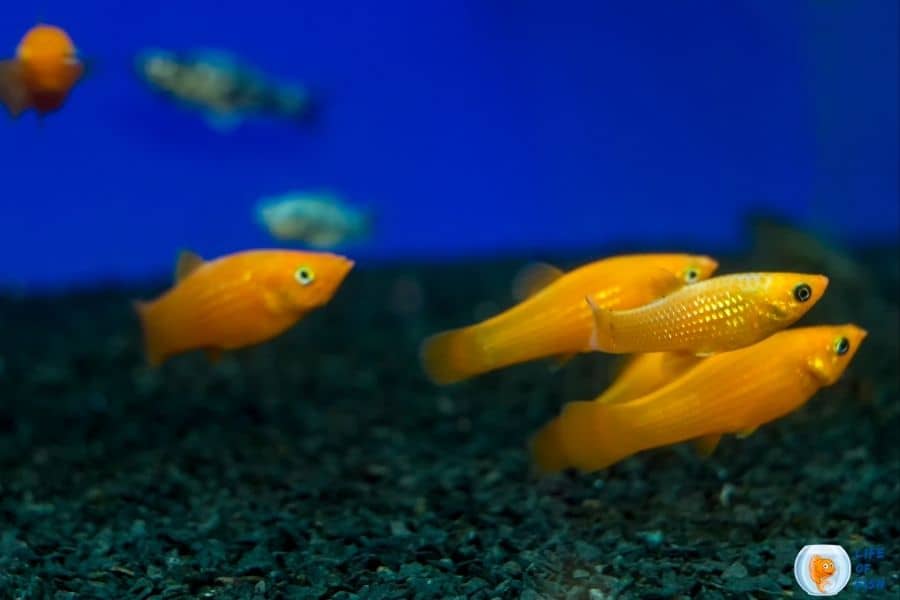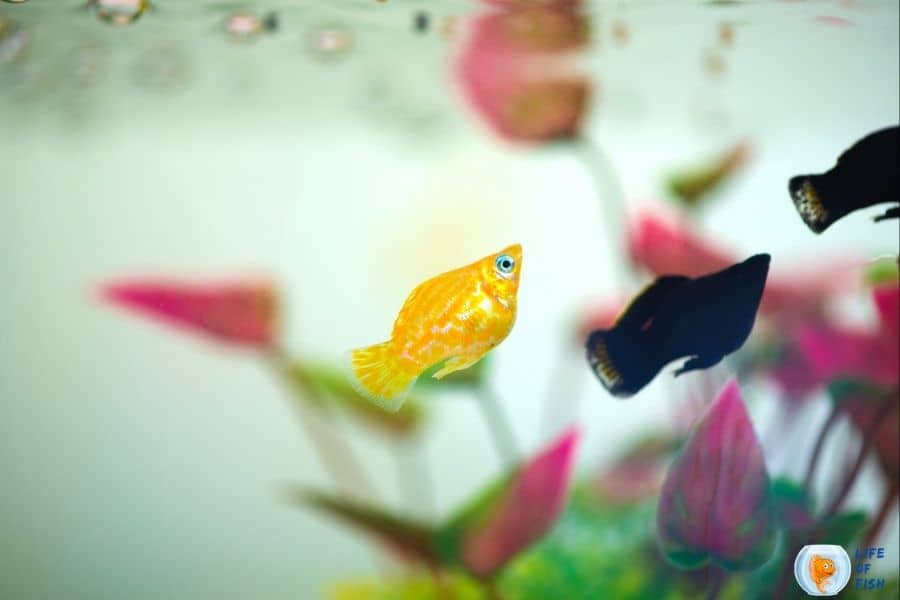Mollies are hardy fish that can survive in both freshwater and saltwater. Native to the Southern United States and Central America, they can be found in a variety of habitats, including brackish water and estuaries. However, some hobbyists prefer to keep mollies in a freshwater aquarium.
Do mollies need a heater? Yes. Although these fish can survive in various habitats, they are used to the tropical climates in the wild.
So, they expect the same temperature in their aquarium. A heater is necessary to keep the water temperature comfortable for mollies, especially if you live in a colder area.
But is it required to keep a heater in a molly tank? What if the temperature gets too cold or too hot? This article will discuss the heater requirement of mollies in depth.

Do mollies need a heater?
Jump To
- 1 Do mollies need a heater?
- 2 Can mollies live without a heater?
- 3 Can mollies live in cold water?
- 4 What happens to mollies when kept in too cold water?
- 5 What happens to mollies when water is too hot?
- 6 Ideal water temperature for mollies
- 7 How to set up a heater for a molly tank
- 8 Fish that don’t need a heater
- 9 Conclusion
Mollies are tropical fish that will do best in an aquarium with a water temperature of 75-80 degrees Fahrenheit.
If the water temperature drops below 75 F or rises above 80 degrees Fahrenheit, your mollies may become stressed, and it could compromise their health.
A heater is the best way to maintain the water temperature in your molly tank at a comfortable level, but it is not mandatory.
If you live in a warmer climate or well-heated house, you may not need to use a heater. However, if the temperature in your region falls below 75 degrees Fahrenheit or rises above 80 degrees Fahrenheit, you should use a heater to keep your mollies healthy.
Do balloon mollies need a heater?
Yes. The requirements of balloon mollies don’t differ from those of regular mollies.
So, if you have a balloon molly, you should use a heater to keep the water temperature in your tank at a comfortable level.
Do Dalmatian mollies need a heater?
Yes. Dalmation mollies also need a heater like any other molly species.
Do black mollies need a heater?
Yes. Almost all the molly species are used to living in tropical climates. Therefore, all molly species, including black mollies, need a heater to keep the water temperature at a comfortable level.
Do baby mollies need a heater?
Yes. Since baby mollies are still developing, they need a heater to ensure that the water temperature in their tank is within a comfortable range.
Baby mollies have less tolerant levels to both hot and cold water temperatures than adult mollies.
Can mollies live without a heater?
If you live in an area that maintains a hot climate all year round, mollies can live well without a heater.
If your area is prone to seasonal temperature changes, they may not be able to survive in your aquarium.
Mollies can survive in a relatively cold temperature for a long time, but only if the temperature doesn’t fluctuate often. If the temperature changes constantly, your molly will have trouble adjusting and could get sick or die.
Can mollies live in cold water?
As mentioned before, mollies can live in relatively cold water.
But if the temperature drops below their tolerance level, they will become stressed, and their health could be compromised.
What happens to mollies when kept in too cold water?
When you keep your mollies in too cold water, you may not see a sudden change from your mollies.
You may think that they are actually fine in cold water by watching that they do fine. But, in reality, they are not. Cold temperature affects mollies in several ways.
Stress
Since mollies live in hot water conditions, they expect the same temperature from your aquarium.
When you keep them in too cold water, the fish sense it right away. They suddenly become stressed as they know they can’t tolerate this temperature.
The stress itself doesn’t kill the fish immediately, but recurring stress can kill your fish when your fish lives in too cold water for a prolonged period of time.
Stunted growth
If you keep your mollies in cold water for an extended period, they may not grow to their full potential size.
This is because the colder water slows down their metabolism and limits their food intake. Eventually, the fish will shut down altogether and die.
Weaker immune system
In cold water, mollies have a more challenging time fighting off diseases.
This is because their immune system becomes suppressed when the fish is constantly stressed. When mollies can’t fight off infections, they get sick and may eventually die.
Suspended reproduction
In cold water, the mollies’ reproduction process is also hindered.
This is because the colder temperature slows down their reproductive process. When mollies can’t reproduce, the population of mollies in your aquarium will eventually decline.

What happens to mollies when water is too hot?
While mollies can not live in too cold water, they can not live in too hot water either. Too hot water also negatively affects your mollies in several ways.
Reduced oxygen levels
When the water is too hot, the oxygen levels in the water decrease. As fish needs oxygen to survive, too hot water can suffocate your fish.
Stressed
Like when the water is too cold, mollies become stressed when the water is too hot. As mentioned before, stress can lead to fish getting sick and dying.
Halted growth
In too hot water, mollies’ growth is also halted.
This is because the high temperature speeds up their metabolism and limits their food intake. Just like in too cold water, if the hot temperature persists, the fish will eventually die.
Weaker immune system
In too hot water, mollies have a harder time fighting off diseases.
Their immune system becomes suppressed when the fish is constantly stressed. When mollies can’t fight off infections, they get sick and may eventually die.
Suspended Nitrogen Cycle
Too hot temperature can temporally suspend the nitrogen cycle in an aquarium with too hot water.
This is because the high temperature speeds up the biochemical process. When the nitrogen cycle is stopped, the ammonia and nitrite levels in the water increase. As fish can’t tolerate high ammonia and nitrite levels, too hot water can kill your fish.
Ideal water temperature for mollies
As you can see, both extreme temperatures (too cold or too hot) are not suitable for your mollies.
Keeping the water temperature within their tolerance range is best to keep your mollies healthy and happy. This range is typically 75-80 degrees Fahrenheit.
Your mollies may be able to survive in slightly different temperatures, but the temperature needs to be steady. Avoid fluctuations in water temperature, as they can also be stressful for your fish.
If you can’t keep the water temperature at 75-80 degrees Fahrenheit, you may need to purchase a heater for your aquarium. Heaters are available in various sizes and prices, so be sure to do your research before you buy.
How to set up a heater for a molly tank
If you decide to use a heater in your molly tank, it is essential to set it up correctly. Improper heater installation can not only be dangerous for your fish but also for you.
Generally, an aquarium needs a 5 watts per gallon heater. So, if you have a 20-gallon aquarium, you will need a 100-watt heater.
Heaters also come in different sizes, so be sure to get a heater that is the right size for your aquarium.
If the aquarium heater is too small, it will not be able to heat the water to the desired temperature. If the heater is too large, it can overheat your aquarium and cause severe damage.
Some heaters are meant to install horizontally, while others are intended to install vertically. Make sure you install the heater in the correct position, or it may not work correctly.
Further, it will be more efficient when you install it near the filter as the filter current can distribute the heat better.
When setting up your heater, make sure to follow the manufacturer’s instructions. Also, be sure to unplug the water heater when not using it. If left plugged in, heaters can overheat and cause a fire.
Fish that don’t need a heater
Now you know that mollies need a heater to survive in a fish tank. Are there any fish that don’t need a heater? Fortunately, there are.
If you don’t prefer using a heater and still want to keep an aquarium or a pond, you have a few other fish options.
Goldfish
One of the best fish for unheated aquariums or ponds is the goldfish.
Goldfish can endure a wide range of water temperatures, from cool to hot. So, if you live in a climate where the temperature drops below 60 degrees Fahrenheit, you don’t need to worry about using a heater.
Koi fish
Another fish that can tolerate cooler water temperatures is the koi fish.
Koi are a type of carp and can thrive even in cold temperatures. In fact, they can even survive in waters that have ice on them.
Endler’s Livebearer
If you are looking for a small-sized fish that can tolerate warmer water temperatures, the Endler’s livebearer is a good choice. This fish can tolerate temperatures down to 64°F, so a heater is unnecessary in most climates.
Bristlenose Pleco
Another fish that can thrive without a heater is the Bristlenose Pleco.
This fish comes from the Amazon River Basin and can tolerate water temperatures up to 86°F and down to 60°F. So, even if your tank gets a little too toasty, the Bristlenose Pleco can handle it.
Conclusion
Mollies need a heater to live in a fish tank. If the water temperature falls below 75°F or rises above 80°F, the mollies will become stressed and may die.
If you can’t keep the water temperature at 75-80°F, you may need to purchase a heater for your aquarium. Heaters are available in various sizes and prices, so be sure to do your research before you buy.
Read Next : Do Molly Fish Need A Filter? | The Answer Will Suprise You | Do Mollies Eat Algae ? ( Everything You Need To Know )
